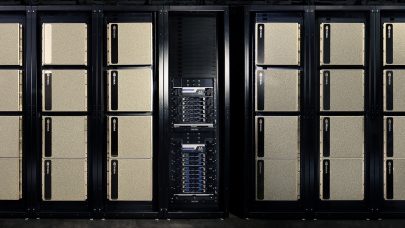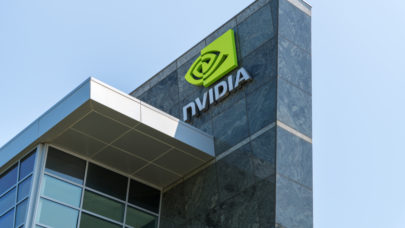
Nvidia’s New Blackwell GPU Can Train AI Models with Trillions of Parameters
March 18, 2024
Nvidia's latest and fastest GPU, codenamed Blackwell, is here and will underpin the company's AI plans this year. The chip offers performance improvements from Read more…

India Is an AI Powerhouse Waiting to Happen, but Challenges Await
March 12, 2024
The Indian government is pushing full speed ahead to make the country an attractive technology base, especially in the hot fields of AI and semiconductors, but Read more…

Grace Hopper’s Big Debut in AWS Cloud While Graviton4 Launches
November 29, 2023
Editors Note: Additional Coverage of the AWS-Nvidia 65 Exaflop ‘Ultra-Cluster’ and Graviton4 can be found on our sister site Datanami. Amazon Web Service Read more…

Annual GPU Upgrades: Nvidia’s Plan for Faster Chips
October 16, 2023
If you are waiting in a giant line for Nvidia's H100 GPUs, be advised that the next-generation H200 chip is already on its way. The GPU maker earlier this mo Read more…

Nvidia H100: Are 550,000 GPUs Enough for This Year?
August 17, 2023
The GPU Squeeze continues to place a premium on Nvidia H100 GPUs. In a recent Financial Times article, Nvidia reports that it expects to ship 550,000 of its lat Read more…

Nvidia Launches AI Factories in DGX Cloud Amid the GPU Squeeze
July 25, 2023
Nvidia is now renting out its homegrown AI supercomputers with its newest GPUs in the cloud for those keen to access its hardware and software packages. Th Read more…

Nvidia Announces Four Supercomputers, with Two in Taiwan
May 29, 2023
At the Computex event in Taipei this week, Nvidia announced four new systems equipped with its Grace- and Hopper-generation hardware, including two in Taiwan. T Read more…

Nvidia to Offer a ‘1 Exaflops’ AI Supercomputer with 256 Grace Hopper Superchips
May 28, 2023
We in HPC sometimes roll our eyes at the term “AI supercomputer,” but a new system from Nvidia might live up to the moniker: the DGX GH200 AI supercomputer. Read more…

- Click Here for More Headlines

Whitepaper
Transforming Industrial and Automotive Manufacturing
In this era, expansion in digital infrastructure capacity is inevitable. Parallel to this, climate change consciousness is also rising, making sustainability a mandatory part of the organization’s functioning. As computing workloads such as AI and HPC continue to surge, so does the energy consumption, posing environmental woes. IT departments within organizations have a crucial role in combating this challenge. They can significantly drive sustainable practices by influencing newer technologies and process adoption that aid in mitigating the effects of climate change.
While buying more sustainable IT solutions is an option, partnering with IT solutions providers, such and Lenovo and Intel, who are committed to sustainability and aiding customers in executing sustainability strategies is likely to be more impactful.
Learn how Lenovo and Intel, through their partnership, are strongly positioned to address this need with their innovations driving energy efficiency and environmental stewardship.
Download Now
Sponsored by Lenovo
Whitepaper
How Direct Liquid Cooling Improves Data Center Energy Efficiency
Data centers are experiencing increasing power consumption, space constraints and cooling demands due to the unprecedented computing power required by today’s chips and servers. HVAC cooling systems consume approximately 40% of a data center’s electricity. These systems traditionally use air conditioning, air handling and fans to cool the data center facility and IT equipment, ultimately resulting in high energy consumption and high carbon emissions. Data centers are moving to direct liquid cooled (DLC) systems to improve cooling efficiency thus lowering their PUE, operating expenses (OPEX) and carbon footprint.
This paper describes how CoolIT Systems (CoolIT) meets the need for improved energy efficiency in data centers and includes case studies that show how CoolIT’s DLC solutions improve energy efficiency, increase rack density, lower OPEX, and enable sustainability programs. CoolIT is the global market and innovation leader in scalable DLC solutions for the world’s most demanding computing environments. CoolIT’s end-to-end solutions meet the rising demand in cooling and the rising demand for energy efficiency.
Download Now
Sponsored by CoolIT
Advanced Scale Career Development & Workforce Enhancement Center
Featured Advanced Scale Jobs:
HPCwire Resource Library
HPCwire Product Showcase
© 2024 HPCwire. All Rights Reserved. A Tabor Communications Publication
HPCwire is a registered trademark of Tabor Communications, Inc. Use of this site is governed by our Terms of Use and Privacy Policy.
Reproduction in whole or in part in any form or medium without express written permission of Tabor Communications, Inc. is prohibited.
























